The Reporter Who Obtained the Viral Video of Dan Hurley Was Reportedly Threatened by a UConn Official
In today’s digital world, the power of social media is undeniable, and the rapid spread of videos can bring immediate attention to any situation—especially when a high-profile individual like Dan Hurley, head coach of the University of Connecticut (UConn) men’s basketball team, is involved. The recent viral video showing Hurley in an emotionally charged moment during a game has stirred up significant media attention and public interest. However, behind the video’s circulation, a troubling issue has surfaced: the reporter who obtained the footage was reportedly threatened by a UConn official.
This article delves into the background of the incident, the nature of the threat, and the broader implications it may have for press freedom, journalistic integrity, and the relationship between universities and the media.
The Viral Video of Dan Hurley
Dan Hurley, a veteran coach known for his intense coaching style and fiery sideline demeanor, had already made a name for himself as the head coach of UConn’s men’s basketball team. His leadership had helped elevate the program, and his passion for the game was well-known to players, fans, and analysts alike. However, the video that recently went viral showed Hurley in a much more personal and heated moment.
The video, which quickly gained millions of views, appeared to capture a brief but intense interaction between Hurley and a referee during a game. The footage showed Hurley expressing visible frustration with the calls being made, yelling, and gesturing animatedly from the sideline. The video was significant not just because of the high emotional stakes it captured, but also because of the context: UConn was in the midst of a crucial game, with Hurley’s temper flaring as the match was on the line.
The video’s widespread sharing quickly led to online debates. Some fans viewed it as an honest display of the pressure and emotions that come with coaching at the highest level, while others criticized Hurley’s behavior as unprofessional or excessive. Nonetheless, it was a clip that sparked widespread conversation, not only about Hurley’s conduct but also about the intense pressure athletes and coaches are under.
The Reporter Who Obtained the Footage
Amid the media frenzy surrounding the video, the reporter who obtained the footage and shared it with the public has been thrust into the spotlight. As with many breaking stories in the digital age, the reporter’s identity initially remained a subject of curiosity. Given the timing and context of the video’s release, the reporter—whose primary role was to cover UConn basketball—had done what any journalist would: acquire the footage and share it with the world.
According to several sources, the reporter who captured the viral video was not only working to provide the public with a transparent view of what occurred but was also acting in the spirit of journalistic integrity. In an era where transparency and accountability are central to maintaining the media’s trustworthiness, it is essential for reporters to present raw, unfiltered content that accurately reflects the events unfolding.
In this instance, the reporter’s work was in line with the public’s desire for insight into what happened on the basketball court. As news outlets and social media platforms began to pick up the video, it became clear that it had the potential to drive significant discussions and highlight issues of leadership and pressure in collegiate sports.
The Alleged Threat from a UConn Official
What followed, however, took an unexpected and concerning turn. Reports surfaced that the journalist who had obtained the viral video of Hurley was allegedly threatened by a UConn official in retaliation for the publication of the footage. According to multiple sources familiar with the situation, the official—who held a position within the athletic department—allegedly made a veiled threat, warning the reporter that their future access to the university’s sports events could be compromised if they continued to cover the team in such a manner.
The threat was reportedly not a direct, physical threat but rather a more insidious warning: that the journalist’s ability to attend future games, obtain interviews, and cover UConn basketball in a professional capacity would be jeopardized. While the official’s exact words are not publicly available, the implication was clear: continued coverage of the UConn team, especially if it was critical of its head coach, could lead to a loss of press credentials or access.
This kind of behavior from a university official is deeply troubling for several reasons. First and foremost, it raises concerns about the role of the media in holding individuals and institutions accountable. A threat to limit or revoke a journalist’s access because of their coverage—especially when it involves a public figure’s conduct—strikes at the heart of press freedom and free speech.
The Impact of Threatening the Press
Threatening a reporter, particularly one who is performing their duty to inform the public, poses significant risks to the broader landscape of journalism. Press freedom is a cornerstone of democratic society, ensuring that the public has access to critical information and that those in power are held accountable for their actions. The alleged threat from a UConn official underscores a growing tension between universities and the media, particularly when it comes to covering high-profile athletic programs.
Journalists play a crucial role in investigating and documenting incidents that may otherwise go unnoticed. Without the presence of the press, incidents like the viral video of Dan Hurley could be swept under the rug, allowing individuals in power to avoid scrutiny. In this case, the reporter was simply providing the public with insight into an important moment in the game. The attempt to silence or intimidate a journalist undermines not only the integrity of the media but also the transparency of the institution involved.
Moreover, the threat to deny access to the reporter is problematic because it sets a dangerous precedent. It suggests that universities and other powerful institutions may feel entitled to control the narrative by restricting access to reporters who do not comply with their preferred portrayal. This undermines the role of the media as a check on power and poses a risk to the public’s trust in the information they receive.
UConn’s Response and Public Reaction
Following the reports of the threat against the reporter, UConn officials came under fire from various media organizations, journalists, and supporters of press freedom. The university initially declined to comment on the allegations, stating that they were “investigating the matter.” However, in the days following, a spokesperson for the university issued a statement condemning any action that would seek to intimidate the press or impede journalistic freedom. The spokesperson clarified that the university’s athletic department was reviewing the situation and would take appropriate action if the allegations were found to be true.
The university’s response, while an attempt to distance itself from the actions of the individual official, did little to quell the controversy. The public reaction was swift and overwhelming. Journalists, advocacy groups, and media organizations rallied around the reporter, demanding that the university take a firm stance on defending press freedom and ensure that such incidents would not be repeated in the future.
One key area of focus was the responsibility of universities, particularly in the realm of athletics, to maintain open and transparent relationships with the media. College sports programs, especially those with national recognition like UConn’s, are heavily dependent on media coverage to generate attention and revenue. If universities want to maintain a healthy relationship with the press, they must respect the role of journalists in capturing both the positive and negative aspects of the athletic experience.
A Broader Discussion on Media and University Relationships
The controversy surrounding UConn’s alleged retaliation against the reporter brings to light a more significant issue: the sometimes problematic relationship between universities and the media. Colleges and universities, especially those with powerful athletic programs, often seek to control their public image. In many cases, this desire for control can lead to clashes with reporters who are merely doing their job.
In some instances, universities may seek to limit media access or influence coverage by imposing restrictions on journalists or selectively granting press credentials. This kind of behavior is detrimental to both the media and the institution itself. A free and independent press is essential to maintaining accountability and transparency, particularly in the realm of higher education and college athletics.
In the case of UConn, the controversy surrounding the viral video and the alleged threat serves as a reminder of the importance of protecting journalistic rights and ensuring that reporters can operate without fear of retaliation. Universities must recognize that the media’s role is not to act as a public relations arm but to report the truth, even when that truth is uncomfortable for those in power.
The viral video of Dan Hurley’s heated moment on the sidelines sparked widespread attention, but it was the response to the reporter who obtained the footage that became the most troubling aspect of the story. The alleged threat from a UConn official highlights the growing tension between universities and the press, raising important questions about press freedom, journalistic integrity, and transparency in college athletics.
As this story continues to unfold, it serves as a stark reminder of the challenges that reporters face in their efforts to uncover and share the truth. If universities like UConn want to maintain positive relationships with the media and the public, they must respect the role of journalism in exposing the full range of experiences, both positive and negative, that occur within their programs.
Ultimately, the pursuit of truth in journalism must remain a priority—regardless of how powerful the individuals or institutions involved may be. The press must be allowed to do its job without fear of intimidation or retaliation, and universities must be held accountable when they seek to silence reporters or control the narrative. In the end, the public’s right to know is paramount, and the protection of that right must always come first.


